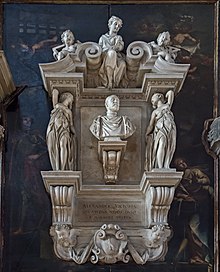Alessandro Vittoria


Alessandro Vittoria (1525 – 27 May 1608) was an Italian Mannerist sculptor of the Venetian school, "one of the main representatives of the Venetian classical style"[1] and rivalling Giambologna as the foremost sculptors of the late 16th century in Italy, producing works such as Annunciation (Art Institute of Chicago).[2]
Biography
Vittoria was born Alessandro Vittoria di Vigilio della Volpa, in Trento, Italy, in what is now northern Italy, and was the son of a tailor. Vittoria was trained in the atelier of the architect-sculptor Jacopo Sansovino; he was a contemporary of Titian whose influence can be detected in his compositions. He was a virtuoso in terracotta, often presented with gilded surfaces, marble and bronze. Like all Italian sculptors of his generation, Vittoria was influenced also by Michelangelo and by the Florentine Mannerist, Bartolomeo Ammannati. The closeness of his associations in projects by architects Sansovino, Sanmicheli and Palladio, working with painters Titian, Tintoretto and Veronese[3] placed him squarely among the protagonists of the art world in late 16th-century Venice.
Career

Vittoria was first trained in his native city, Trento, then moved to Venice on 25 July 1543, where he trained and worked with Jacopo Sansovino.[4] His long artistic relationship with Sansovino was a stormy one. After one quarrel with Sansovino, he removed from Venice and worked in Vicenza, where he collaborated with Veronese on the decorations of the Villa Barbaro at Maser (1560–62) before returning. The two masters worked jointly on great sculptural commissions until Sansovino's death. Vittoria took up his studio and completed Sansovino's unfinished commissions. His pupils included Camillo Mariani and Andrea di Alessandro.
Vittoria joined the Scuola Grande di San Marco on 24 January 1563 and the Accademia del Disegno, Florence, c. 1567.
He died at Venice on 27 May 1608. His tomb, with his self-portrait bust, is in the church of San Zaccaria.
Vittoria is known for his classicising portrait busts, a genre that scarcely existed in Venice before him,[5] and for medals as well as for his full-length figures, some of which surmount Sansovino's Biblioteca Marciana.
Sources
His diary is an important source for the details of his career, as is his will, of 29 July 1576.[6] An exhibition at Trento, 1999 is memorialised in a catalogue by Andrea Bacchi, Lia Camerlengo and Manfred Leithe-Jasper, "La Bellissima Maniera": Alessandro Vittoria e la Scultura Veneta del Cinquecento (Trento 1999) which is the basic text for its introductory essays on Vittoria's art and career, by Manfred Leithe-Jasper; his patrons, by Thomas Martin; his connections with Venetian painting, by Stefano Tumidei; and Vittoria's role as a collector, by Victoria Avery.
Gallery
- San Zaccaria, San Zaccaria, Venice
- Saint Roch, San Francesco della Vigna, Venice
- Saint Roch, San Salvador, Venice
- Saint Sebastian, San Francesco della Vigna, Venice
- Saint Sebastian, San Salvador, Venice
- John the Evangelist, San Zanipolo, Venice
- Virgin of pain, San Zanipolo, Venice
- Cast of Vittoria's bust of Apollonio Massa
Notes
- ^ Federico Zeri and Elizabeth E, Gardner, Italian Paintings: Venetian School (Metropolitan Museum of Art) 1973, p. 87, Portrait of Alessandro Vittoria by Paolo Veronese, acc. no. 46.31 (on-line catalogue); the sculptor poses with a model of his Saint Sebastian for the Montefeltro altar in the Church of San Francesco della Vigna, Venice, of which small bronzes exist (e.g. Metropolitan Museum, acc. no. 40.24)
- ^ Thomas Martin, Alessandro Vittoria and the Portrait Bust in Renaissance Venice: Remodelling Antiquity (Oxford University Press) 1998.
- ^ Veronese's portrait with a model of his Saint Sebastian, ca 1570, is at the Metropolitan Museum of Art (On-line catalog).
- ^ Victoria Charles (24 Nov 2014). 1000 Masterpieces of Decorative Art. Parkstone International. p. 194. ISBN 9781783104604.
- ^ Martin 1998; there exists no adequate monograph on Vittoria or catalogue of his works
- ^ Giuseppe Gerola, "Nuove documenti veneziani su Alessandro Vittoria" Atti del Reale Instituto Veneto di Scienze, Lettere ed Arti 84 (1925:349-50).









